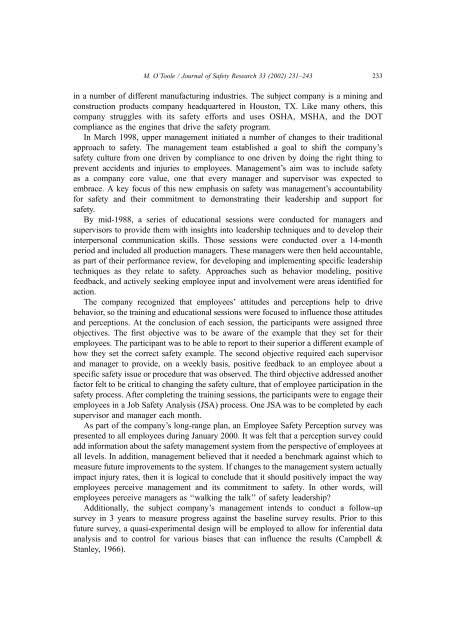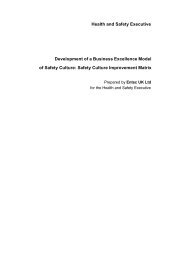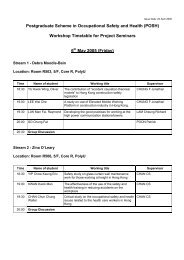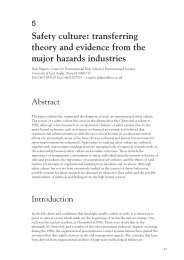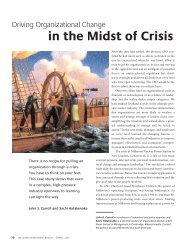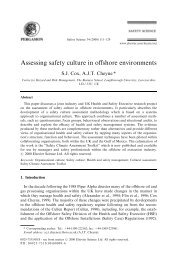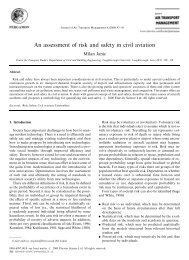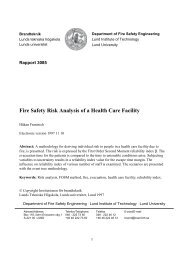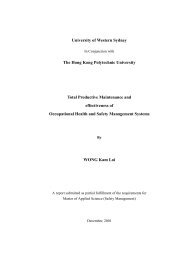The relationship between employees' perceptions of safety and ...
The relationship between employees' perceptions of safety and ...
The relationship between employees' perceptions of safety and ...
Create successful ePaper yourself
Turn your PDF publications into a flip-book with our unique Google optimized e-Paper software.
M. O’Toole / Journal <strong>of</strong> Safety Research 33 (2002) 231–243 233<br />
in a number <strong>of</strong> different manufacturing industries. <strong>The</strong> subject company is a mining <strong>and</strong><br />
construction products company headquartered in Houston, TX. Like many others, this<br />
company struggles with its <strong>safety</strong> efforts <strong>and</strong> uses OSHA, MSHA, <strong>and</strong> the DOT<br />
compliance as the engines that drive the <strong>safety</strong> program.<br />
In March 1998, upper management initiated a number <strong>of</strong> changes to their traditional<br />
approach to <strong>safety</strong>. <strong>The</strong> management team established a goal to shift the company’s<br />
<strong>safety</strong> culture from one driven by compliance to one driven by doing the right thing to<br />
prevent accidents <strong>and</strong> injuries to employees. Management’s aim was to include <strong>safety</strong><br />
as a company core value, one that every manager <strong>and</strong> supervisor was expected to<br />
embrace. A key focus <strong>of</strong> this new emphasis on <strong>safety</strong> was management’s accountability<br />
for <strong>safety</strong> <strong>and</strong> their commitment to demonstrating their leadership <strong>and</strong> support for<br />
<strong>safety</strong>.<br />
By mid-1988, a series <strong>of</strong> educational sessions were conducted for managers <strong>and</strong><br />
supervisors to provide them with insights into leadership techniques <strong>and</strong> to develop their<br />
interpersonal communication skills. Those sessions were conducted over a 14-month<br />
period <strong>and</strong> included all production managers. <strong>The</strong>se managers were then held accountable,<br />
as part <strong>of</strong> their performance review, for developing <strong>and</strong> implementing specific leadership<br />
techniques as they relate to <strong>safety</strong>. Approaches such as behavior modeling, positive<br />
feedback, <strong>and</strong> actively seeking employee input <strong>and</strong> involvement were areas identified for<br />
action.<br />
<strong>The</strong> company recognized that employees’ attitudes <strong>and</strong> <strong>perceptions</strong> help to drive<br />
behavior, so the training <strong>and</strong> educational sessions were focused to influence those attitudes<br />
<strong>and</strong> <strong>perceptions</strong>. At the conclusion <strong>of</strong> each session, the participants were assigned three<br />
objectives. <strong>The</strong> first objective was to be aware <strong>of</strong> the example that they set for their<br />
employees. <strong>The</strong> participant was to be able to report to their superior a different example <strong>of</strong><br />
how they set the correct <strong>safety</strong> example. <strong>The</strong> second objective required each supervisor<br />
<strong>and</strong> manager to provide, on a weekly basis, positive feedback to an employee about a<br />
specific <strong>safety</strong> issue or procedure that was observed. <strong>The</strong> third objective addressed another<br />
factor felt to be critical to changing the <strong>safety</strong> culture, that <strong>of</strong> employee participation in the<br />
<strong>safety</strong> process. After completing the training sessions, the participants were to engage their<br />
employees in a Job Safety Analysis (JSA) process. One JSA was to be completed by each<br />
supervisor <strong>and</strong> manager each month.<br />
As part <strong>of</strong> the company’s long-range plan, an Employee Safety Perception survey was<br />
presented to all employees during January 2000. It was felt that a perception survey could<br />
add information about the <strong>safety</strong> management system from the perspective <strong>of</strong> employees at<br />
all levels. In addition, management believed that it needed a benchmark against which to<br />
measure future improvements to the system. If changes to the management system actually<br />
impact injury rates, then it is logical to conclude that it should positively impact the way<br />
employees perceive management <strong>and</strong> its commitment to <strong>safety</strong>. In other words, will<br />
employees perceive managers as ‘‘walking the talk’’ <strong>of</strong> <strong>safety</strong> leadership?<br />
Additionally, the subject company’s management intends to conduct a follow-up<br />
survey in 3 years to measure progress against the baseline survey results. Prior to this<br />
future survey, a quasi-experimental design will be employed to allow for inferential data<br />
analysis <strong>and</strong> to control for various biases that can influence the results (Campbell &<br />
Stanley, 1966).


